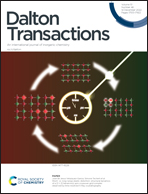Cluster-derived TiO2 nanocrystals with multiple carbon coupling for interfacial pseudo-capacitive lithium storage†
Abstract
TiO2 is one of the most promising anode materials for lithium ion batteries (LIBs) due to its safe working potentials and small volume changes during lithium insertion/extraction. However, its inherently poor electronic and ionic conductivities have restricted its practical applications. Herein, well-defined TiO2 nanocrystals were prepared from an atomically precise titanium-oxo cluster (Ti8Ph) and then coupled with carbon layers and graphene nanosheets. When used as anode materials for LIBs, the TiO2-C-rGO composite delivered a high capacity of 834 mA h g−1 at 0.1 A g−1 after 300 cycles and 398 mA h g−1 at 5.0 A g−1 after 600 cycles, which are far superior to those of the control samples (TiO2-C, TiO2-rGO and TiO2) and most other reported TiO2-based nanostructures. The exposed facets of TiO2 nanocrystals were favorable for lithium diffusion and the carbon coupling was beneficial for the electron transfer. The latter also enhanced the structural robustness and hence the cycling stability of the composite. Moreover, the abundant three-phase interfaces between the carbon species and the TiO2 nanocrystals endowed the material with rich adsorption sites and substantially boosted pseudo-capacitive lithium storage. This work offered an alternative route to rationally design versatile nanostructures from clusters and contributed to the development of high-efficiency energy materials.



 Please wait while we load your content...
Please wait while we load your content...